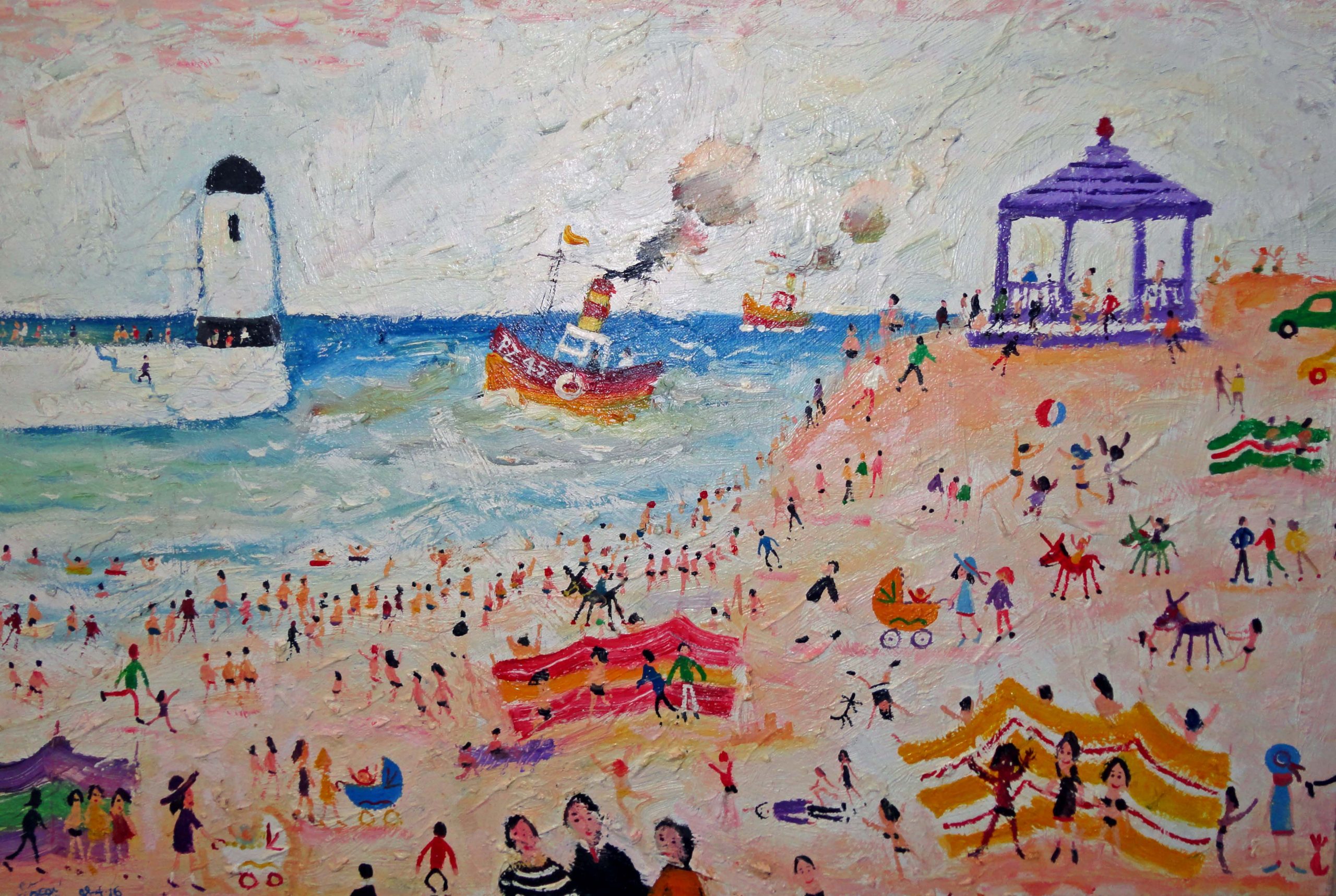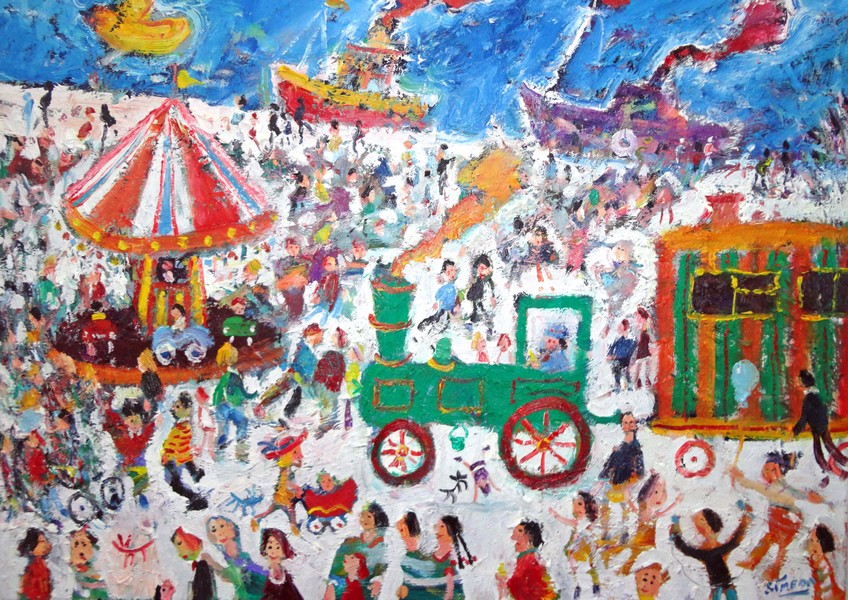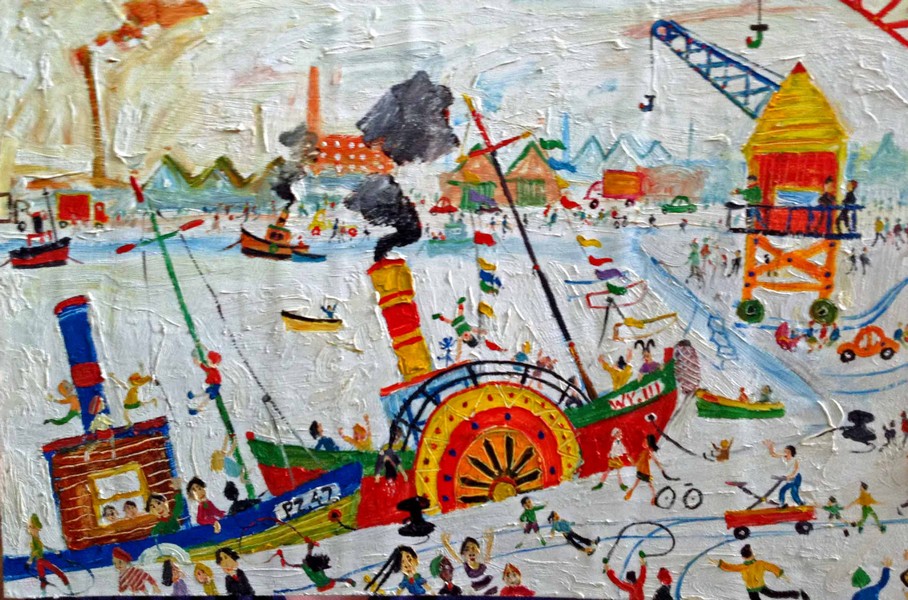
Introduction to Simeon Stafford and the English Naive School
The English Naive School refers to a group of artists who were self-taught or had minimal formal training in art, yet created captivating and unique works that captured the essence of everyday life. One such artist who is widely recognized as a leading figure in this school is Simeon Stafford.
Born in 1956 in rural Cheshire, England, Stafford’s humble upbringing greatly influenced his artistic style. Growing up on a farm, he developed a deep appreciation for nature and the simple joys of life.
Despite not receiving any formal art education, Stafford’s passion and talent for painting led him to pursue it as a career. He started exhibiting his work at local galleries and quickly gained recognition for his distinct style. In 1982, he held his first solo exhibition in London which received critical acclaim and marked the beginning of his successful artistic journey.
Stafford’s paintings are known for their vibrant colors, meticulous attention to detail, and whimsical depictions of everyday scenes. His subjects range from bustling city streets to serene countryside landscapes, capturing the beauty and charm of both urban and rural life.
The History and Characteristics of the English Naive School
The term “naive” or “primitive” was first used by French art critics to describe paintings that lacked formal training and technical expertise. However, this term has evolved over time and is now seen as a positive attribute, celebrated for its authenticity and honesty.
The roots of the English Naive School can be traced back to rural communities where ordinary people, without any formal training in art, would create paintings as a way of recording their daily lives. These works were often colorful and whimsical, depicting scenes from nature or everyday activities such as farming, hunting, or family gatherings.
One of the earliest known naive painters in England was George Morland (1763-1804), whose rustic landscapes and depictions of country life captured the imagination of many. However, it wasn’t until later in the 19th century that the genre gained recognition as an official school of art.

Simeon Stafford’s Life and Artistic Journey
Simeon Stafford was a renowned English artist who is known for his unique style and timeless appeal in the world of art. He was born in 1956 in Stoke-on-Trent, England and grew up surrounded by the rich culture and history of the city. From a young age, Stafford showed a passion and talent for painting, which led him to pursue a career as an artist.
Stafford’s journey as an artist began when he attended the Burslem School of Art, where he developed his skills and techniques in various mediums such as watercolor, oil paint, and acrylics. His education at this prestigious school allowed him to experiment with different styles and forms of art, but it was during his time there that he discovered his love for naive art.
Naive art is characterized by its simplicity and childlike charm. It often features vibrant colors, bold lines, and whimsical subjects that reflect everyday life. This style immediately resonated with Stafford, who found joy in capturing the beauty of everyday scenes through his paintings.
After completing his studies at Burslem School of Art, Simeon Stafford embarked on a journey to explore new horizons. He traveled extensively throughout Europe, Africa, Asia, and North America – drawing inspiration from diverse cultures and landscapes along the way. This exposure to different cultures greatly influenced Stafford’s artistic vision and played a significant role in shaping his distinctive style.
Exploring Stafford’s Style and Techniques

Simeon Stafford’s art is renowned for its timeless appeal, capturing the essence of everyday life in a way that resonates with viewers from all walks of life. His works are characterized by a distinct style and technique that sets him apart from other artists of his time, making him one of the most celebrated figures of the English Naive School.
Stafford’s Style:
Stafford’s paintings reflect this influence through his use of bold colors, flat perspective, and simplified forms. His subjects are often portrayed in a naturalistic manner, with expressive faces and gestures that convey their emotions. The use of thick outlines and vivid hues adds to the whimsical quality of his work, giving it a strong visual impact.
One can also observe elements of impressionism in Stafford’s style as he captures light and shadow with loose brushstrokes, creating a sense of movement within his compositions. This blend of naive and impressionistic techniques gives his art a unique charm that has captivated audiences for decades.
Preserving the Legacy of English Naive School: Current Exhibitions and Collections
The English Naive School, also known as the Primitive or Folk Art movement, emerged in the 18th century and has since then captured the hearts of art enthusiasts with its simplistic yet charming style. One of the pioneers of this movement was Simeon Stafford, whose paintings continue to be celebrated for their timeless appeal.
To preserve and honor the legacy of English Naive School, various exhibitions and collections have been curated over the years. These showcase not only Stafford’s works but also those of other notable artists who were part of this movement.
One such exhibition is “Folk Art & Magic: The Enchanted World of Simeon Stafford”, which took place at Manchester Art Gallery in 2019. This exhibition featured over 80 paintings by Stafford, including some never-before-seen pieces from private collections. It offered a comprehensive look into his artistic journey and highlighted his unique vision that blended everyday scenes with elements of fantasy.
Another recent exhibition that paid tribute to Stafford’s contribution to the English Naive School was “A Celebration of Simeon Stafford” at Castle Fine Art in Birmingham in 2020. This exhibition brought together a collection of rare paintings from throughout his career, showcasing his versatility and mastery in capturing both rural landscapes and bustling cityscapes.
Apart from these solo exhibitions dedicated to Stafford, several galleries regularly feature collections that include his works alongside other artists from the English Naive School. The Lowry museum in Salford houses an impressive collection that includes artworks by both Simeon Stafford and Lowry.
Impact of Simeon Stafford and the English Naive School on Contemporary Art
The impact of Simeon Stafford and the English Naive School on contemporary art cannot be overstated. While the term “naive” may bring to mind images of simplistic or childlike art, the work of Stafford and his contemporaries in this genre is far from simple. Their paintings are rich in detail, emotion, and storytelling, creating a timeless appeal that continues to inspire artists today.
One of the most significant ways that Stafford and the English Naive School have influenced contemporary art is through their rejection of traditional academic standards. In contrast to the highly technical and formal works of academic artists, naive artists like Stafford embraced a more spontaneous and intuitive approach to painting. This freedom from strict rules allowed them to create more personal and emotive pieces that resonated with viewers on a deeper level.
Stafford’s use of bold colors, gestural brushstrokes, and simplified forms also had a significant impact on contemporary art movements such as Expressionism, Fauvism, and Primitivism. His ability to capture everyday scenes with an expressive flair challenged conventional notions of beauty in art and paved the way for future generations of artists to experiment with color, form, and subject matter.
Moreover, the English Naive School’s emphasis on depicting ordinary people engaged in everyday activities has been a source of inspiration for contemporary realist painters. By elevating seemingly mundane moments into works of beauty and significance, Stafford brought attention to everyday life as a worthy subject for artistic exploration.
Conclusion: Why Simeon Stafford’s Art is Timeless
Simeon Stafford’s art has stood the test of time and continues to captivate audiences with its unique charm and beauty. As we have explored in this article, his work embodies the essence of the English Naive School, capturing everyday scenes with a sense of nostalgia and simplicity.
One of the main reasons why Stafford’s art is timeless is because it holds so much significance and relevance to people. His paintings depict relatable moments that evoke feelings of warmth, familiarity, and joy. Whether it’s a bustling street scene or a peaceful countryside landscape, each piece captures a moment in time that speaks to our shared human experiences.
Moreover, Stafford’s use of vibrant colors adds to the enduring appeal of his art. The bold hues he incorporates into his compositions bring life to his subjects and surroundings, making them feel alive and full of energy. This element adds depth and dimension to his artwork, drawing viewers in and keeping them engaged for years to come.
Furthermore, one cannot overlook the technical skill behind Simeon Stafford’s works. Despite being self-taught, he mastered the techniques necessary to create visually stunning pieces that showcase his keen eye for detail and composition. Each stroke of paint on his canvas is purposeful and deliberate, resulting in a cohesive masterpiece that stands out among other artworks.
